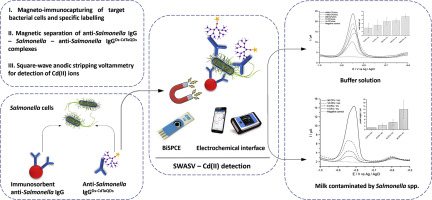当前位置:
X-MOL 学术
›
J. Electroanal. Chem.
›
论文详情
Our official English website, www.x-mol.net, welcomes your
feedback! (Note: you will need to create a separate account there.)
Direct culture-free electrochemical detection of cells in milk based on quantum dots-modified nanostructured dendrons
Journal of Electroanalytical Chemistry ( IF 4.1 ) Pub Date : 2020-04-01 , DOI: 10.1016/j.jelechem.2020.114051 Pavla Murasova , Aneta Kovarova , Jitka Kasparova , Iveta Brozkova , Audrey Hamiot , Jana Pekarkova , Bruno Dupuy , Jana Drbohlavova , Zuzana Bilkova , Lucie Korecka
Journal of Electroanalytical Chemistry ( IF 4.1 ) Pub Date : 2020-04-01 , DOI: 10.1016/j.jelechem.2020.114051 Pavla Murasova , Aneta Kovarova , Jitka Kasparova , Iveta Brozkova , Audrey Hamiot , Jana Pekarkova , Bruno Dupuy , Jana Drbohlavova , Zuzana Bilkova , Lucie Korecka

|
Abstract With regard to global food safety and preventing the spread of diseases caused by foodborne pathogens or their toxins, there is an increasing need for simple and rapid methods for the screening of such pathogens. We aimed to develop a fast and efficient biosensor for the screening of milk samples contaminated by Salmonella spp. and provide a quick and cost-effective method as an alternative to the time-consuming conventional cultivation- or PCR-based approaches. We exploited a simple but highly specific technique whereby bacterial cells were separated immunomagnetically, with subsequent reaction with conjugate; i.e. specific IgG molecule labelled with an electrochemically potent indicator. The unique structure of this indicator exploits the benefits of hyperbranched dendron molecules and heavy metal–derived quantum dots (QDs). Square-wave anodic stripping voltammetry (SWASV) using of screen-printed carbon electrodes with in situ formed Bi(III) film (BiSPCE) was used for the detection and quantification of metal ions released from the QDs (CdTe) after their acidic dissolution. The metal ion signals proportionally correlate with the amount of captured bacteria cells. By this method, the presence of Salmonella spp. was proven in 2.5 h even in minimal number of bacterial cells (4 CFU) in 1 mL of the sample.
中文翻译:

基于量子点修饰纳米结构树突的牛奶细胞免培养直接电化学检测
摘要 为了全球食品安全和防止由食源性病原体或其毒素引起的疾病传播,越来越需要简单快速的方法来筛查此类病原体。我们旨在开发一种快速有效的生物传感器,用于筛查受沙门氏菌污染的牛奶样品。并提供一种快速且具有成本效益的方法,作为耗时的传统培养或 PCR 方法的替代方法。我们利用了一种简单但高度特异性的技术,通过免疫磁性分离细菌细胞,随后与偶联物反应;即用电化学有效指示剂标记的特定 IgG 分子。该指标的独特结构利用了超支化树枝状分子和重金属衍生量子点 (QD) 的优势。方波阳极溶出伏安法 (SWASV) 使用丝网印刷碳电极与原位形成的 Bi(III) 膜 (BiSPCE),用于检测和量化 QD (CdTe) 在酸溶解后释放的金属离子。金属离子信号与捕获的细菌细胞数量成正比。通过这种方法,沙门氏菌的存在。即使 1 mL 样品中的细菌细胞数量最少 (4 CFU),也能在 2.5 小时内得到证明。沙门氏菌的存在。即使 1 mL 样品中的细菌细胞数量最少 (4 CFU),也能在 2.5 小时内得到证明。沙门氏菌的存在。即使 1 mL 样品中的细菌细胞数量最少 (4 CFU),也能在 2.5 小时内得到证明。
更新日期:2020-04-01
中文翻译:

基于量子点修饰纳米结构树突的牛奶细胞免培养直接电化学检测
摘要 为了全球食品安全和防止由食源性病原体或其毒素引起的疾病传播,越来越需要简单快速的方法来筛查此类病原体。我们旨在开发一种快速有效的生物传感器,用于筛查受沙门氏菌污染的牛奶样品。并提供一种快速且具有成本效益的方法,作为耗时的传统培养或 PCR 方法的替代方法。我们利用了一种简单但高度特异性的技术,通过免疫磁性分离细菌细胞,随后与偶联物反应;即用电化学有效指示剂标记的特定 IgG 分子。该指标的独特结构利用了超支化树枝状分子和重金属衍生量子点 (QD) 的优势。方波阳极溶出伏安法 (SWASV) 使用丝网印刷碳电极与原位形成的 Bi(III) 膜 (BiSPCE),用于检测和量化 QD (CdTe) 在酸溶解后释放的金属离子。金属离子信号与捕获的细菌细胞数量成正比。通过这种方法,沙门氏菌的存在。即使 1 mL 样品中的细菌细胞数量最少 (4 CFU),也能在 2.5 小时内得到证明。沙门氏菌的存在。即使 1 mL 样品中的细菌细胞数量最少 (4 CFU),也能在 2.5 小时内得到证明。沙门氏菌的存在。即使 1 mL 样品中的细菌细胞数量最少 (4 CFU),也能在 2.5 小时内得到证明。











































 京公网安备 11010802027423号
京公网安备 11010802027423号